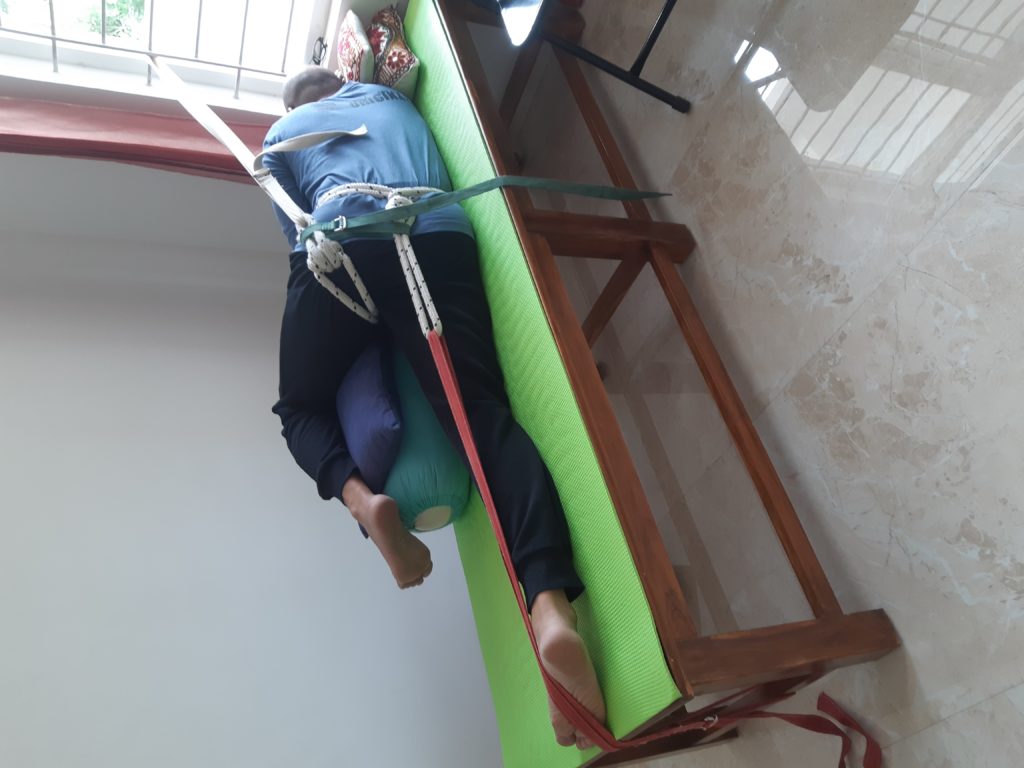Rope & Belt Therapy – long term Pain Relief
Rope & Belt therapy for Joint pain relief
Rope & Belt Therapy is a therapeutic form of Yoga that is extremely helpful in Joint pain relief and is used for relieving even severe Joint Pain.
Conception of the Rope and Belt therapy
The use of props like ropes, belts, bolsters, pillows, bricks, blankets, vipreet dandasana bench, tressler, halasana bench and other yoga props was started by Guruji BKS Iyengar, to work on body alignment and to achieve the maximum potential from a yogasana. Asanas done with the help of Rope Therapy are far more balanced, optimally aligned, and can have better rib cage opening, better spinal rotation, intense and accurate forward bends and safe backbends. This could be very difficult to achieve without Rope yoga.
Later, his Disciple Dr SV Karandikar gave a medical angle to the usage of these props. Having a Medical background and a deep understanding of Anatomy & Physiology, he enhanced the usage of yoga props to treat musculoskeletal disorders with the help of Rope & Belt therapy.
Major Joint problems addressed by Rope & belt therapy
The rope therapy approach has tremendous benefits for patients having severe degrees of:
-
- Lumbar Spondylitis, Sciatica pain, prolapsed disc
-
- Cervical Spondylitis (Neck pain/shoulder pain)
This therapy works on Alignment correction, Traction & Distraction at Joints

How does Rope & Belt therapy work?
Rope & Belt therapy involves extensive use of props. The main props are the therapeutic belts and ropes, specifically designed for the purpose. Therapeutic belts have different lengths, different types of buckle attachments, and different stitching styles to accommodate the required loops for certain postures. Some of the belts are as long as 180 inches or as short as 36 inches. Similarly, the therapeutic ropes also have different lengths. Some of them are as long as 4 meters or as short as 1.5 meters. During Rope therapy, these therapeutic Ropes & pain relief Belts are used in a specific manner, with acute anatomical precision, to correct the alignment around the anatomical axis. example: to do a medial or lateral rotation of the femur, medial rotation of the fibula or lifting of the foot arches!
Rope & belt yoga works by giving traction to joints and extended holding time in asanas to increase the length of the muscle/increase flexibility. Incorrect alignment puts pressure on the joint at the point where the effect could be damaging in the long term. Hence, as we correct the body alignment, it automatically reduces pressure on the joints, a breather for its revival!
Similarly, in the cases of lower back pain, cervical pain and severe knee pain (read about knee pain management), traction works on elongation and extension of the joint at a target point. It also helps in medial & lateral rotation of the joint, wherever required. Rope & belt therapy also provides support to the joint during the day as the belts can be easily be worn/tied for up to 3 to 4 hours during the day. There are special belts that can be tied around the pelvis or around the knee for hours to give support to the structure. The tying method is practised by the patient in front of the therapist. Soon a patient can do it on his own very conveniently.
Target benefits of Rope & Belt Therapy
- Pain relief – As the therapy progresses, joint pain starts reducing and the need for taking painkillers is also reduces
- Correct body alignment – Therapy aims at correcting the postural alignment which is important to maintain the effect of treatment. Incorrect alignment might zero out the effect of any treatment.
- Relief from muscle stiffness – Since the postures are held for a longer duration, with the help of props, muscles start to gain length. As a result, muscles also become supple and flexible.
- Improvement in Range of Motion (ROM) – As the pain is reduced and muscles regain their flexibility, the range of motion at the target joint improves gradually. This gives confidence to the patient in doing day-to-day activities like walking, climbing stairs, gardening, cycling etc.
- Better quality of life – Life feels good and effortless with a healthy, pain-free body. As the patient gains confidence in doing his day-to-day activities better, their hope towards enjoying life comes back. They feel like doing many extra-curricular activities that they would have been avoiding. Even a little improvement boosts their morale and brings positivity.
How to start Rope & Belt therapy with Innersaga
Stage 1: Consultation
Every client approaching us must go through a consultation session which is an assessment of this physical condition. He may be advised further investigation reports like X-ray / MRI/ Blood reports done to enable us to understand the problem better.
Step 2: Therapy
After clinical investigation and taking his history, the therapeutic approach is advised, whether it will be a Medical yoga approach or specifically a Rope & Belt therapy. Normally, Rope & Belt treatment is advised for a minimum 2 weeks and it can last up to 3 months (for example: in the case of 3rd grade Osteo-Arthritis of the Knee, min. 3 three-month period is required to bring the desired impact)
Non-Invasive method
This therapy is non-invasive. It is a modification of
Ashtanga yoga asanas to enable the patients to get maximum benefit despite
their physical condition. Along with Rope & belt treatment, patients also
experience sessions of Pranayama and meditation to bring a holistic effect.
Don’t choose to suffer from pain, rather choose to give yourself a chance and fetch health for yourself!